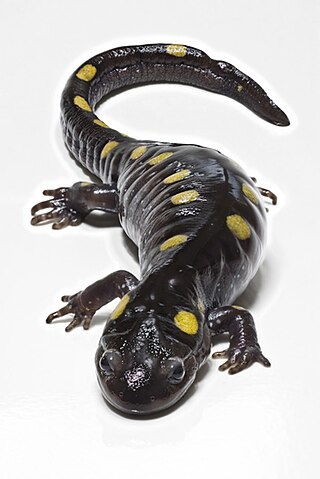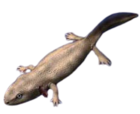
Amphibians are ectothermic, anamniotic, four-limbed vertebrate animals that constitute the class Amphibia. In its broadest sense, it is a paraphyletic group encompassing all tetrapods excluding the amniotes. All extant (living) amphibians belong to the monophyletic subclass Lissamphibia, with three living orders: Anura, Urodela (salamanders), and Gymnophiona (caecilians). Evolved to be mostly semiaquatic, amphibians have adapted to inhabit a wide variety of habitats, with most species living in freshwater, wetland or terrestrial ecosystems. Their life cycle typically starts out as aquatic larvae with gills known as tadpoles, but some species have developed behavioural adaptations to bypass this.

Salamanders are a group of amphibians typically characterized by their lizard-like appearance, with slender bodies, blunt snouts, short limbs projecting at right angles to the body, and the presence of a tail in both larvae and adults. All ten extant salamander families are grouped together under the order Urodela from the group Caudata. Urodela is a scientific Latin term based on the Ancient Greek οὐρά δήλη: ourà dēlē "conspicuous tail". Caudata is the Latin for "tailed ones", from cauda: "tail".

North Amherst is a census-designated place (CDP) in the city of Amherst in Hampshire County, Massachusetts, United States. The population was 6,819 at the 2010 census, up from 6,019 at the 2000 census. It is part of the Springfield, Massachusetts Metropolitan Statistical Area.

The tiger salamander is a species of mole salamander and one of the largest terrestrial salamanders in North America.

Plethodon is a genus of salamanders in the family Plethodontidae. They are commonly known as woodland salamanders. All members of the genus are endemic to North America. They have no aquatic larval stage. In some species, such as the red-backed salamander. Young hatch in the adult form. Members of Plethodon primarily eat small invertebrates. The earliest known fossils of this genus are from the Hemphillian of Tennessee in the United States.

Salamander, retitled Life Force in North America and in the Japanese arcade re-release, is a scrolling shooter arcade video game developed and published by Konami. Released in 1986 as a spin-off of Gradius, Salamander introduced a simplified power-up system, two-player cooperative gameplay and both horizontally and vertically scrolling stages. Some of these later became normal for future Gradius games. In Japanese, the title is written using ateji, which are kanji used for spelling foreign words that has been supplanted in everyday use by katakana. Contra, another game by Konami was also given this treatment, with its title written in Japanese as 魂斗羅.

The Fort Ancient culture is a Native American archaeological culture that dates back to c. 1000–1750 CE. Members of the culture lived along the Ohio River valley, in an area running from modern-day Ohio and western West Virginia through to northern Kentucky and parts of southeastern Indiana. A contemporary of the neighboring Mississippian culture, Fort Ancient is considered to be a separate "sister culture". Mitochondrial DNA evidence collected from the area suggests that the Fort Ancient culture did not directly descend from the older Hopewell Culture.

The Jefferson salamander is a mole salamander native to the northeastern United States, southern and central Ontario, and southwestern Quebec. It was named after Jefferson College in Pennsylvania.
Richard Highton is an American herpetologist, an expert on the biological classification of woodland salamanders.
Archaeotriton is an extinct genus of prehistoric salamanders. The only identified species in the genus is A. basalticus, which lived during the Oligocene in Central Europe.
Comonecturoides is an extinct genus of prehistoric caudate amphibians, possibly a salamander, from Reed's Quarry 9 of the Morrison Formation, near Como Bluff, Wyoming; the type species is C. marshi. It is considered a nomen dubium because the name is based on non-distinctive remains which cannot be classified in detail.
Iridotriton is an extinct genus of prehistoric salamander known from a fossil found in stratigraphic zone 6 of the late Jurassic Morrison Formation in the Dinosaur National Monument. One species has been described, Iridotriton hechti. It is likely a member of Cryptobranchoidea.
Lisserpeton is an extinct genus of prehistoric salamander of the Hell Creek Formation. Its closest living relatives are the mole salamanders.
Laccotriton is an extinct genus of prehistoric salamanders which lived in Eastern Asia during the Early Cretaceous. A nearly complete skeleton of L. subsolanus was found at Hebei, China.
Enneabatrachus is an extinct genus of prehistoric frogs known from the late Jurassic Morrison Formation of the United States and also the Late Jurassic-Early Cretaceous Ksar Metlili Formation of Morocco. The type species is E. hechti, whose remains have been recovered from stratigraphic zone 5.
Batrachosauroididae is an extinct family of prehistoric salamanders with holarctic distribution. They were paedomorphic and presumably aquatic. They are possibly the sister taxon of Proteidae, an extant family of aquatic salamanders. They are definitively known from the Late Cretaceous to Miocene of North America and Europe. Remains from the earliest Cretaceous (Berriasian) Lulworth Formation of England have tenatively been attributed to this family.

Florida hosts many types of fauna. From coral reefs of the Florida Keys to the cypress swamps of the Panhandle, the state's diverse habitats are home to a variety of wildlife. Florida is among the top five states in terms of endemic species. There are over 700 terrestrial animals, 200 freshwater fish species, 1,000 marine fish and thousands of terrestrial insects and other invertebrates that inhabit the state. Florida's peninsular geography spans from subtropical to tropical zones, which, combined with its distinctive geology and climate, contribute to habitat diversity and an array of species. The native wildlife that exists in the state are of temperate and tropical origin.












